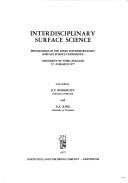| Listing 1 - 2 of 2 |
Sort by
|

ISBN: 0444419713 9780444507457 0444507450 0080542123 9780080542126 9780444511522 9780444514370 0444514376 0080498345 9780080498348 9780080532677 0080532675 Year: 1981 Publisher: Amsterdam Elsevier
Abstract | Keywords | Export | Availability | Bookmark
 Loading...
Loading...Choose an application
- Reference Manager
- EndNote
- RefWorks (Direct export to RefWorks)
Description Surface Alloys and Alloy Surfaces is concerned with the structural, compositional, electronic and chemical properties of the surfaces of solids in which the surface layers, at least are alloyed. Two different categories of system are covered - the surfaces of bulk alloys (alloy surfaces) and surface phases in which one or more outermost atomic layers are alloyed, while the underlying bulk involves no such intermixing (surface alloys). Importance of Topic The surfaces of bulk alloys have long been known to be of practical interest for their chemical properties. It has also long been known that the surface composition of such alloys commonly differs from that of the underlying bulk. However, our understanding of these chemical and physical phenomena is far from complete and the application of surface science methods to investigate these phenomena is a manifestation of a general trend to study the surfaces of increasing complexity. Surface alloy formation, as a much more recently recognized phenomenon deserves more attention. Why This Title This title is important as it provides new insights into a mixture of new and old problems. It is the first to cover the important mixture of material on surface alloys and alloy surfaces. Each chapter is written by experts in different areas of these two interrelated topics, covering theory and experiment, physics and chemistry, geometrical and electronic structure. The coverage of the surface alloy topic is especially novel as it is relatively newly-recognised as quite a common phenomenon. While much of traditional surface science has been concerned with equilibrium properties and simple kinetics, there is a growing effort in the area of dynamical processes at surfaces. This book draws together a series of chapters written by acknowledged experts in the field, which describe progress in a range of specific topics. The emphasis is on chemical reaction dynamics, including both theoretical and experimental approaches and covering work on low index single crystal surfaces, on stepped surfaces and on supported metal clusters. Other processes, such as surface diffusion are also addressed. Further chapters discuss dynamical processes in electronically-induced desorption, and in surface diffusion on semiconductors and metals. - Presents considerable advances in surface science field - Collection of expert reviews in surface dynamics. Although there has been steady progress in understanding aspects of epitaxial growth throughout the last 30 years of modern surface science, work in this area has intensified greatly in the last 5 years. A number of factors have contributed to this expansion. One has been the general trend in surface science to tackle problems of increasing complexity as confidence is gained in the methodology, so for example, the role of oxide/metal interfaces in determining the properties of many practical supported catalysts is now being explored in greater detail. A second factor is the recognition of the potential importance of artificial multilayer materials not only in semiconductor devices but also in metal/metal systems because of their novel magnetic properties. Perhaps even more important than either of these application areas, however, is the newly-discovered power of scanning probe microscopies, and most notably scanning tunneling microscopy (STM), to provide the means to study epitaxial growth phenomena on an atomic scale under a wide range of conditions. These techniques have also contributed to revitalised interest in methods of fabricating and exploiting artificial structures (lateral as well as in layers) on a nanometre scale. This volume, on Growth and Properties of Ultrathin Epitaxial Layers, includes a collection of articles which reflects the present state of activity in this field. The emphasis is on metals and oxides rather than semiconductors. The objective in initiating this series in 1980 was to provide an in-depth review of advances made in the understanding key aspects of surface chemistry and physics through the application of new techniques to the study of well-defined surfaces. Since then the field of surface science has greatly matured, and further important techniques, particularly scanning probe microscopies, have been successfully assimilated into the applications armoury of the surface scientist. The present volume is a series of timely reviews by many of the current experts in the field of phase transitions and adsorbate-induced surface restructuring. No aspect of the science of solid surfaces can be fully understood without accounting for the structural diversity of surfaces, now revealed in atomic detail by techniques based on diffraction and scanning probe microscopies. For example, it is now clear to those working in heterogeneous catalysis that adsorbate-induced restructuring of surfaces can play a critical role in phenomena such as bistability, kinetic oscillations, and promotion and poisoning. Structural transitions at surfaces can also play a key role in determining the electronic properties of surfaces, reviewed in volume 5.

ISBN: 0444850511 Year: 1977 Publisher: Amsterdam North-Holland
Abstract | Keywords | Export | Availability | Bookmark
 Loading...
Loading...Choose an application
- Reference Manager
- EndNote
- RefWorks (Direct export to RefWorks)
| Listing 1 - 2 of 2 |
Sort by
|

 Search
Search Feedback
Feedback About UniCat
About UniCat  Help
Help News
News